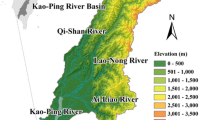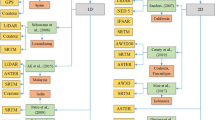Abstract
Daniau Village in Daniau Creek Watershed, Taitung County, Taiwan, sustained damages from landslides and mudflows during Typhoon Morakot in 2009. The purpose of this study is to adopt the FLO-2D numerical model recognized by Federal Emergency Management Agency (FEMA) to simulate the mudflow, and the Daniau Village was used as a case study, along with rainfall and digital terrain data for this simulation. On the basis of sediment yields, the residual sediment volume in the landslide area was determined to be 33,276 m3 by comparison of digital elevation models (DEMs) and by using the universal soil loss equation (USLE). In addition, this study performed a hydrological frequency analysis of rainfall to estimate the flow discharge as conditions of the simulation. Results of disaster surveys were collected to compare with outputs of the numerical model. Results of the simulation conducted with FLO-2D indicated that if the countermeasure was not destroyed, the drainage work would function without overflow. This study aimed to review the effectiveness of countermeasure on the basis of simulation results obtained by using the model to provide references for future disaster prevention and resident evacuation plans.
Similar content being viewed by others
References
Aleotti P, Polloni G (2003) Two-dimensional model of the 1998 Sarno debris flows (Italy): preliminary results. In: Rickenmann D, Chen CL (Eds.), Third International Conference on Debris-Flow Hazards Mitigation: Mechanics, Prediction and Assessment. Davos, Switzerland. pp. 553–563.
Armento MC, Genevois R, Tecca PR (2008) Comparison of numerical models of two debris flows in the Cortina d’Ampezzo area, Dolomites, Italy. Landslides 5(1): 143–150.
Bedient PB, Huber WC (2002) Hydrology and Floodplain Analysis. Prentice Hall Publishing, New Jersey, USA.
Chen SC, Chen LK (2002) The Planning and Enforcement of Evacuation and Shelter System for Debris Flow Disaster. In: Chen SC (Eds.), Proceedings of the International Conference on Debris-Flow Disaster Mitigation Strategy, Chinese Taipei. pp. 253–272.
Chen SC, Huang BT (2010) Non-structural mitigation programs for sediment-related disasters after the Chichi Earthquake in Taiwan. Journal of Mountain Science 7(3): 291–300.
Chen SC, Wu CY, Huang BT (2010) The efficiency of a risk reduction program for debris-flow disasters — a case study of the Songhe community in Taiwan. Natural Hazards and Earth System Sciences 10(7): 1591–1603.
Chow VT (1988) Applied Hydrology. McGraw Hill Publishing, New York, USA
Congalton RG, Story M (1986) Accuracy assessment: a user’s perspective. Photogrammetric Engineering and Remote Sensing 55(9): 1303–1309.
Coroza O, Evans D, Bishop I (1997) Enhancing runoff modeling with GIS. Landscape and Urban Planning 38: 13–23.
Croke BFW, Islam A, Ghosh J, et al. (2011) Evaluation of approaches for estimation of rainfall and the unit hydrograph. Hydrology Research 42(5): 372–385.
Garcia R, López JL, Noya M, et al. (2003) Hazard mapping for debris flow events in the alluvial fans of northern Venezuela. In: Rickenmann, D. and Chen, C.L. (eds.), Third International Conference on Debris-Flow Hazards Mitigation: Mechanics, Prediction and Assessment. Davos, Switzerland, pp. 10–12.
Hubl J, Steinwendtner H (2001) Two-dimensional simulation of two viscous debris flows in Austria. Physics and Chemistry of the Earth Part C-Solar-Terrestial and Planetary Science 26(9): 639–644.
Imran J, Parker G, Locat J, et al. (2001) 1D numerical model of muddy subaqueous and subaerial debris flows. Journal of Hydraulic Engineering-ASCE 127(11): 959–968.
Jang CL, Shimizu Y (2007) Numerical analysis of braided rivers and alluvial fan deltas. Engineering Applications of Computational Fluid Mechanics 1(1): 15–24.
Jin M, Fread DL (1999) 1D modeling of mud/debris unsteady flows. Journal of Hydraulic Engineering-ASCE 125(8): 827–834.
Laigle D, Coussot P (1997) Numerical modeling of mudflows. Journal of Hydraulic Engineering-ASCE 123(7): 617–623.
Li CC, Lin A, Tsai YJ (2010) A Study of the Sediment Problem Caused by Typhoon Morakot — Taking the Watershed of Tsengwen Reservoir as an Example. Journal of the Taiwan Disaster Prevention Society 2(1): 51–58. (In Chinese)
O’Brien JS (2006) FLO-2D User’S Manual. Version 2006.01, FLO-2D Software, Inc., Nutrioso.
O’Brien JS, Julien PY, Fullerton WT (1993) Two-dimensional water flood and mudflow simulation. Journal of Hydraulic Engineering-ASCE 119(2): 244–261.
Pastor M, Quecedo M, Gonzalez E, et al. (2004) Simple approximation to bottom friction for Bingham fluid depth integrated models. Journal of Hydraulic Engineering-ASCE 130(2): 149–155.
Shiau JT, Wang HY, Tsai CT (2010) Copula-based depthduration-frequency analysis of typhoons in Taiwan. Hydrology Research 41(5): 414–423.
Sosio R, Crosta GB, Frattini P (2007) Field observations, rheological testing and numerical modelling of a debris-flow event. Earth Surface Processes and Landforms 32(2): 290–306.
Stolz A, Huggel C (2008) Debris flows in the Swiss National Park: the influence of different flow models and varying DEM grid size on modeling results. Landslides 5(3): 311–319.
SWCB (2008) Integrated Watershed Investigation and Planning Manual. Report of Soil and Water Conservation Bureau, Council of Agriculture, Chinese Taipei. (In Chinese)
SWCB (2011) Slopeland Conservation Investigation and Planning of Daniau Coastal Watershed. Report of Soil and Water Conservation Bureau, Council of Agriculture, Chinese Taipei. (In Chinese)
Toyos G, Dorta DO, Oppenheimer C, et al. (2007) GIS-assisted modelling for debris flow hazard assessment based on the events of May 1998 in the area of Sarno, Southern Italy: Part I. Maximum run-out. Earth Surface Processes and Landforms 32(10): 1491–1502.
Vemu S, Pinnamaneni UB (2011) Estimation of spatial patterns of soil erosion using remote sensing and GIS: a case study of Indravati catchment. Natural Hazards 59(3): 1299–1315.
Wanielista MP (1990) Hydrology and Water Quantity Control. John Willey & Sons Publishing, New York, USA.
Wischmeier WH, Smith DD (1978) Predicting rainfall erosion losses. U.S. Department of Agriculture, Agricultural Research Service, Agriculture Handbook 537.
WRA (2009) Hydrological Analysis Report of Typhoon Morakot. Presentation Document of Water Resources Agency, Ministry of Economic Affairs, Chinese Taipei. (In Chinese)
Author information
Authors and Affiliations
Corresponding author
Rights and permissions
About this article
Cite this article
Peng, SH., Lu, SC. FLO-2D simulation of mudflow caused by large landslide due to extremely heavy rainfall in southeastern Taiwan during Typhoon Morakot. J. Mt. Sci. 10, 207–218 (2013). https://doi.org/10.1007/s11629-013-2510-2
Received:
Accepted:
Published:
Issue Date:
DOI: https://doi.org/10.1007/s11629-013-2510-2




